英语修辞格的译法
- 格式:ppt
- 大小:422.00 KB
- 文档页数:32
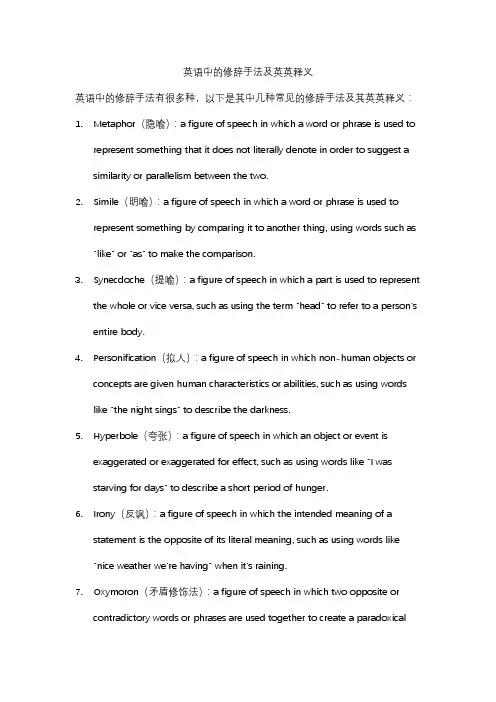
英语中的修辞手法及英英释义英语中的修辞手法有很多种,以下是其中几种常见的修辞手法及其英英释义:1.Metaphor(隐喻):a figure of speech in which a word or phrase is used torepresent something that it does not literally denote in order to suggest a similarity or parallelism between the two.2.Simile(明喻):a figure of speech in which a word or phrase is used torepresent something by comparing it to another thing, using words such as "like" or "as" to make the comparison.3.Synecdoche(提喻):a figure of speech in which a part is used to representthe whole or vice versa, such as using the term "head" to refer to a person's entire body.4.Personification(拟人):a figure of speech in which non-human objects orconcepts are given human characteristics or abilities, such as using words like "the night sings" to describe the darkness.5.Hyperbole(夸张):a figure of speech in which an object or event isexaggerated or exaggerated for effect, such as using words like "I wasstarving for days" to describe a short period of hunger.6.Irony(反讽):a figure of speech in which the intended meaning of astatement is the opposite of its literal meaning, such as using words like"nice weather we're having" when it's raining.7.Oxymoron(矛盾修饰法):a figure of speech in which two opposite orcontradictory words or phrases are used together to create a paradoxicaleffect, such as using words like "bittersweet" to describe a mixed feeling of happiness and sadness.这些修辞手法都可以增强语言的表达力,帮助传达更深刻的意义。
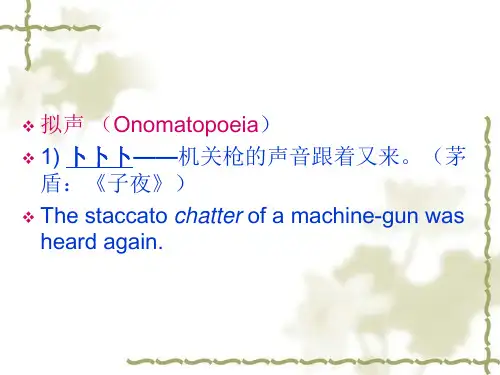
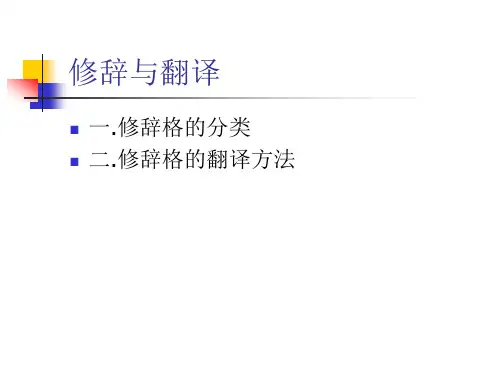
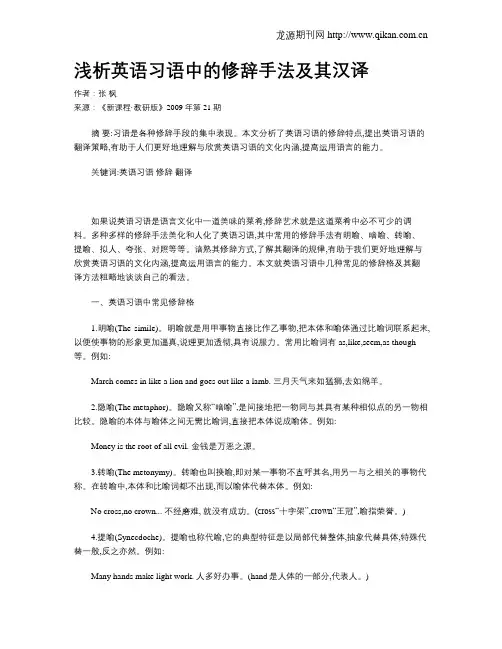
浅析英语习语中的修辞手法及其汉译作者:张枫来源:《新课程·教研版》2009年第21期摘要:习语是各种修辞手段的集中表现。
本文分析了英语习语的修辞特点,提出英语习语的翻译策略,有助于人们更好地理解与欣赏英语习语的文化内涵,提高运用语言的能力。
关键词:英语习语修辞翻译如果说英语习语是语言文化中一道美味的菜肴,修辞艺术就是这道菜肴中必不可少的调料。
多种多样的修辞手法美化和人化了英语习语,其中常用的修辞手法有明喻、暗喻、转喻、提喻、拟人、夸张、对照等等。
谙熟其修辞方式,了解其翻译的规律,有助于我们更好地理解与欣赏英语习语的文化内涵,提高运用语言的能力。
本文就英语习语中几种常见的修辞格及其翻译方法粗略地谈谈自己的看法。
一、英语习语中常见修辞格1.明喻(The simile)。
明喻就是用甲事物直接比作乙事物,把本体和喻体通过比喻词联系起来,以便使事物的形象更加逼真,说理更加透彻,具有说服力。
常用比喻词有as,like,seem,as though 等。
例如:March comes in like a lion and goes out like a lamb. 三月天气来如猛狮,去如绵羊。
2.隐喻(The metaphor)。
隐喻又称“暗喻”,是间接地把一物同与其具有某种相似点的另一物相比较。
隐喻的本体与喻体之间无需比喻词,直接把本体说成喻体。
例如:Money is the root of all evil. 金钱是万恶之源。
3.转喻(The metonymy)。
转喻也叫换喻,即对某一事物不直呼其名,用另一与之相关的事物代称。
在转喻中,本体和比喻词都不出现,而以喻体代替本体。
例如:No cross,no crown... 不经磨难, 就没有成功。
(cross“十字架”,crown“王冠”,喻指荣誉。
)4.提喻(Synecdoche)。
提喻也称代喻,它的典型特征是以局部代替整体,抽象代替具体,特殊代替一般,反之亦然。
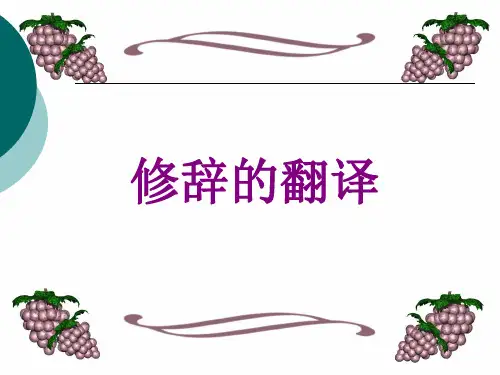
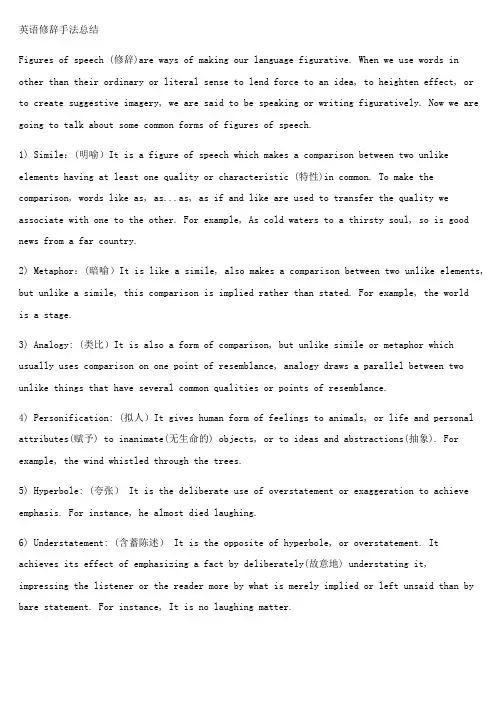
英语修辞手法总结Figures of speech (修辞)are ways of making our language figurative. When we use words in other than their ordinary or literal sense to lend force to an idea, to heighten effect, orto create suggestive imagery, we are said to be speaking or writing figuratively. Now we are going to talk about some common forms of figures of speech.1) Simile:(明喻)It is a figure of speech which makes a comparison between two unlike elements having at least one quality or characteristic (特性)in common. To make the comparison, words like as, as...as, as if and like are used to transfer the quality we associate with one to the other. For example, As cold waters to a thirsty soul, so is good news from a far country.2) Metaphor:(暗喻)It is like a simile, also makes a comparison between two unlike elements, but unlike a simile, this comparison is implied rather than stated. For example, the worldis a stage.3) Analogy: (类比)It is also a form of comparison, but unlike simile or metaphor which usually uses comparison on one point of resemblance, analogy draws a parallel between two unlike things that have several common qualities or points of resemblance.4) Personification: (拟人)It gives human form of feelings to animals, or life and personal attributes(赋予) to inanimate(无生命的) objects, or to ideas and abstractions(抽象). For example, the wind whistled through the trees.5) Hyperbole: (夸张) It is the deliberate use of overstatement or exaggeration to achieve emphasis. For instance, he almost died laughing.6) Understatement: (含蓄陈述) It is the opposite of hyperbole, or overstatement. Itachieves its effect of emphasizing a fact by deliberately(故意地) understating it,impressing the listener or the reader more by what is merely implied or left unsaid than by bare statement. For instance, It is no laughing matter.7) Euphemism: (委婉) It is the substitution of an agreeable or inoffensive(无冒犯) expression for one that may offend or suggest something unpleasant. For instance, we refer to "die" as " pass away".8) Metonymy (转喻)It is a figure of speech that has to do with the substitution of the mane of one thing for that of another. For instance, the pen (words) is mightier than the sword (forces).9) Synecdoche (提喻) It is involves the substitution of the part for the whole, or thewhole for the part. For instance, they say there's bread and work for all. She was dressedin silks.10) Antonomasia (换喻)It has also to do with substitution. It is not often mentioned now, though it is still in frequent use. For example, Solomon for a wise man. Daniel for a wise and fair judge. Judas for a traitor.11) Pun: (双关语) It is a play on words, or rather a play on the form and meaning of words. For instance, a cannon-ball took off his legs, so he laid down his arms. (Here "arms" has two meanings: a person's body; weapons carried by a soldier.)12) Syllepsis: (一语双叙) It has two connotations.In the first case, it is a figure by which a word, or a particular form or inflection of a word, refers to two or more words in the same sentence, while properly applying to or agreeing with only on of them in grammar or syntax(句法). For example, He addressed you and me, and desired us to follow him. (Here us is used to refer to you and me.)In the second case, it a word may refer to two or more words in the same sentence. For example, while he was fighting , and losing limb and mind, and dying, others stayed behind to pursue education and career. (Here to losing one's limbs in literal; to lose one's mindis figurative, and means to go mad.)13) Zeugma: (轭式搭配) It is a single word which is made to modify or to govern two or more words in the same sentence, wither properly applying in sense to only one of them, orapplying to them in different senses. For example, The sun shall not burn you by day, nor the moon by night. (Here noon is not strong enough to burn)14) Irony: (反语) It is a figure of speech that achieves emphasis by saying the opposite of what is meant, the intended meaning of the words being the opposite of their usual sense. For instance, we are lucky, what you said makes me feel real good.15) Innuendo: (暗讽) It is a mild form of irony, hinting in a rather roundabout (曲折)way at something disparaging(不一致) or uncomplimentary(不赞美) to the person or subject mentioned. For example, the weatherman said it would be worm. He must take his readings in a bathroom.16) Sarcasm: (讽刺) It Sarcasm is a strong form of irony. It attacks in a taunting and bitter manner, and its aim is to disparage, ridicule and wound the feelings of the subject attacked. For example, laws are like cobwebs, which may catch small flies, but let wasps break through.17) Paradox: (似非而是的隽语) It is a figure of speech consisting of a statement or proposition which on the face of it seems self-contradictory, absurd or contrary to established fact or practice, but which on further thinking and study may prove to be true, well-founded, and even to contain a succinct point. For example more haste, less speed.18) Oxymoron: (矛盾修饰) It is a compressed paradox, formed by the conjoining(结合) of two contrasting, contradictory or incongruous(不协调) terms as in bitter-sweet memories, orderly chaos(混乱) and proud humility(侮辱).19) Antithesis: (对照) It is the deliberate arrangement of contrasting words or ideas in balanced structural forms to achieve emphasis. For example, speech is silver; silence is golden.20) Epigram: (警句) It states a simple truth pithily(有利地) and pungently(强烈地). It is usually terse and arouses interest and surprise by its deep insight into certain aspects of human behavior or feeling. For instance, Few, save the poor, feel for the poor.21) Climax: (渐进) It is derived from the Greek word for "ladder" and implies the progression of thought at a uniform or almost uniform rate of significance or intensity,like the steps of a ladder ascending evenly. For example, I came, I saw, I conquered.22) Anti-climax or bathos: (突降)It is the opposite of Climax. It involves stating one's thoughts in a descending order of significance or intensity, from strong to weak, from weighty to light or frivolous. For instance, But thousands die, without or this or that, die, and endow(赋予) a college, or a cat.23) Apostrophe: (顿呼) In this figure of speech, a thing, place, idea or person (dead or absent) is addressed as if present, listening and understanding what is being said. For instance, England! awake! awake! awake!24) Transferred Epithet: (转类形容词) It is a figure of speech where an epithet (anadjective or descriptive phrase) is transferred from the noun it should rightly modify(修饰) to another to which it does not really apply or belong. For instance, I spent sleeplessnights on my project.25) Alliteration: (头韵) It has to do with the sound rather than the sense of words for effect. It is a device that repeats the same sound at frequent intervals(间隔) and since the sound repeated is usually the initial consonant sound, it is also called "front rhyme". For instance, the fair breeze blew, the white foam flew, the furrow followed free.26) Onomatopoeia: (拟声) It is a device that uses words which imitate the sounds made by an object (animate or inanimate), or which are associated with or suggestive(提示的) of some action or movementExplanation version1一、什么是修辞格修辞格(figures of speech)是提高语言表达效果的语言艺术。
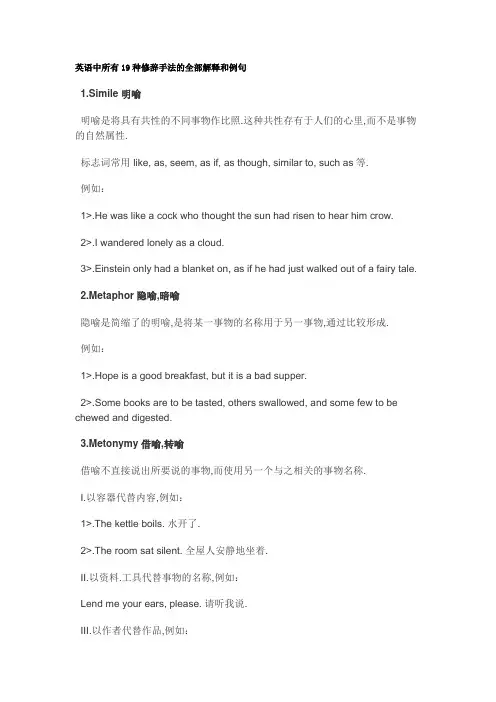
英语中所有19种修辞手法的全部解释和例句1.Simile 明喻明喻是将具有共性的不同事物作比照.这种共性存有于人们的心里,而不是事物的自然属性.标志词常用 like, as, seem, as if, as though, similar to, such as等.例如:1>.He was like a cock who thought the sun had risen to hear him crow.2>.I wandered lonely as a cloud.3>.Einstein only had a blanket on, as if he had just walked out of a fairy tale.2.Metaphor 隐喻,暗喻隐喻是简缩了的明喻,是将某一事物的名称用于另一事物,通过比较形成.例如:1>.Hope is a good breakfast, but it is a bad supper.2>.Some books are to be tasted, others swallowed, and some few to be chewed and digested.3.Metonymy 借喻,转喻借喻不直接说出所要说的事物,而使用另一个与之相关的事物名称.I.以容器代替内容,例如:1>.The kettle boils. 水开了.2>.The room sat silent. 全屋人安静地坐着.II.以资料.工具代替事物的名称,例如:Lend me your ears, please. 请听我说.III.以作者代替作品,例如:a complete Shakespeare 莎士比亚全集VI.以具体事物代替抽象概念,例如:I had the muscle, and they made money out of it. 我有力气,他们就用我的力气赚钱.4.Synecdoche 提喻提喻用局部代替全体,或用全体代替局部,或特殊代替一般.例如:1>.There are about 100 hands working in his factory.(局部代整体)他的厂里约有100名工人.2>.He is the Newton of this century.(特殊代一般)他是本世纪的牛顿.3>.The fox goes very well with your cap.(整体代局部)这狐皮围脖与你的帽子很相配.5.Synaesthesia 通感,联觉,移觉这种修辞法是以视.听.触.嗅.味等感觉直接描写事物.通感就是把不同感官的感觉沟通起来,借联想引起感觉转移,“以感觉写感觉”。
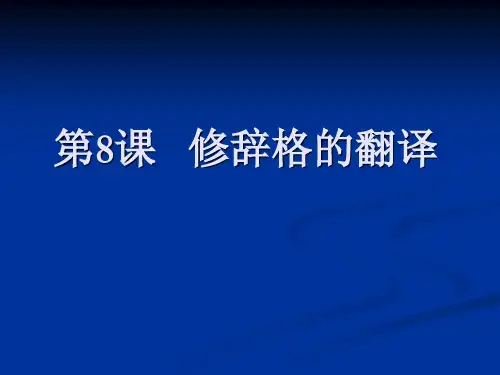
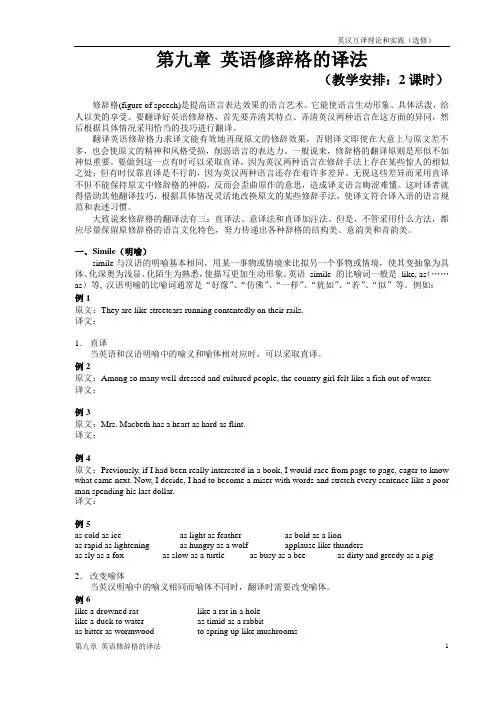
第九章英语修辞格的译法(教学安排:2课时)修辞格(figure of speech)是提高语言表达效果的语言艺术。
它能使语言生动形象、具体活泼,给人以美的享受。
要翻译好英语修辞格,首先要弄清其特点、弄清英汉两种语言在这方面的异同,然后根据具体情况采用恰当的技巧进行翻译。
翻译英语修辞格力求译文能有效地再现原文的修辞效果,否则译文即使在大意上与原文差不多,也会使原文的精神和风格受损,削弱语言的表达力。
一般说来,修辞格的翻译原则是形似不如神似重要。
要做到这一点有时可以采取直译,因为英汉两种语言在修辞手法上存在某些惊人的相似之处;但有时仅靠直译是不行的,因为英汉两种语言还存在着许多差异。
无视这些差异而采用直译不但不能保持原文中修辞格的神韵,反而会歪曲原作的意思,造成译文语言晦涩难懂。
这时译者就得借助其他翻译技巧,根据具体情况灵活地改换原文的某些修辞手法,使译文符合译入语的语言规范和表述习惯。
大致说来修辞格的翻译法有三:直译法、意译法和直译加注法。
但是,不管采用什么方法,都应尽量保留原修辞格的语言文化特色,努力传递出各种辞格的结构美、意韵美和音韵美。
一、Simile(明喻)simile与汉语的明喻基本相同,用某一事物或情境来比拟另一个事物或情境,使其变抽象为具体、化深奥为浅显、化陌生为熟悉,使描写更加生动形象。
英语simile 的比喻词一般是like, as(……as)等, 汉语明喻的比喻词通常是“好像”、“仿佛”、“一样”、“犹如”、“若”、“似”等。
例如:例1原文:They are like streetcars running contentedly on their rails.译文:1.直译当英语和汉语明喻中的喻义和喻体相对应时,可以采取直译。
例2原文:Among so many well-dressed and cultured people, the country girl felt like a fish out of water.译文:例3原文:Mrs. Macbeth has a heart as hard as flint.译文:例4原文:Previously, if I had been really interested in a book, I would race from page to page, eager to know what came next. Now, I decide, I had to become a miser with words and stretch every sentence like a poor man spending his last dollar.译文:例5as cold as ice as light as feather as bold as a lionas rapid as lightening as hungry as a wolf applause like thundersas sly as a fox as slow as a turtle as busy as a bee as dirty and greedy as a pig 2.改变喻体当英汉明喻中的喻义相同而喻体不同时,翻译时需要改变喻体。
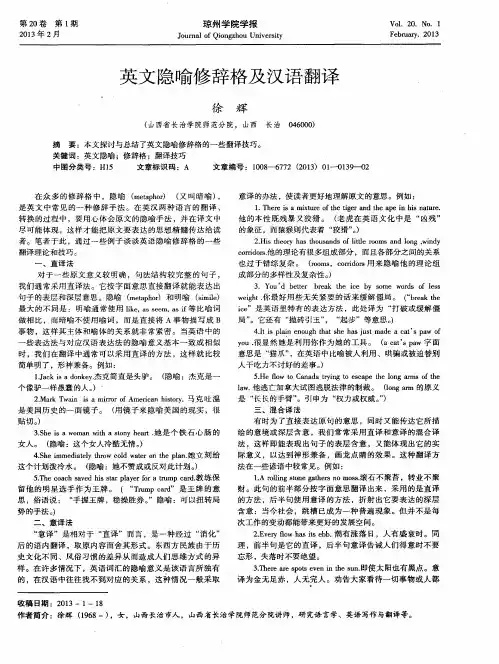
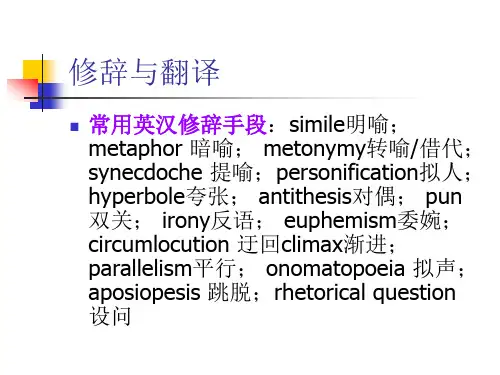
探析英文隐喻修辞格的翻译技巧隐喻修辞格是英语文章中常见的一种修辞手法,它可以丰富文章的意义,增强文章的表现力。
但当这种修辞格被翻译成其他语言时,往往会造成翻译困难,需要掌握一定的翻译技巧。
一、什么是隐喻修辞格?隐喻修辞格是一种修辞手法,在英语文章中常常使用。
它是通过将一个事物与另一个事物进行类比来表达意义。
这种类比关系是建立在两个事物之间的相似之处上的。
例如:“他是一头狮子”这句话中,“他”被比作狮子,表达他的勇猛和强大。
二、隐喻的翻译技巧翻译隐喻修辞格时,需要注意以下几点:1.理解隐喻的意义在翻译中理解隐喻的意义十分重要。
首先,需要理解原文中的意思,弄清楚两个被比较的事物之间的相似之处。
其次,需要理解作者使用隐喻的目的。
例如:“他像一只鹰一样翱翔在天空中”,在这句话中,作者想表达的是他的自由、追求和高飞的状态。
2.寻找翻译隐喻的合适的言语翻译隐喻的关键是找到适当的词语,用其他语言来表达与原文中相似的意义。
因为隐喻一般是建立在英语语言中的文化背景和文化禀赋之上,因此翻译时需要结合文化,用相应的词语来表达隐喻所表达的意义。
例如:“他是一头狮子”,译时可以使用类似的动物来表达同样的意思,如“他是一头猛虎”。
3.保持修辞格的特定特性在翻译隐喻时,需要保持隐喻的特定特性,不能使隐喻丧失原来的意义和表现力。
因为隐喻所包含的意义往往超出了具体比喻的意象本身,而是通过比喻所缔造的隐喻意蕴来间接地表达某种含义,因此,在翻译隐喻时,不仅要翻译出隐喻所涵盖的意义,也要体现出隐喻所包含的情感色彩。
例如:“他像一只鹰一样翱翔在天空中”,这句话传达的是自由、追求和高飞的感觉,翻译时应该在译文中体现出这种情感,否则会使读者感到隐喻的表现力受到了削弱。
三、总结在翻译隐喻修辞格时,需要综合考虑隐喻的含义、语言、文化等因素,尽量搭建出与原文相似相应的新的隐喻意象,以达到保持原文意义和表现力的目的。
因此,要翻译好隐喻修辞格,需要译者具备丰富的语言、文化和修辞知识,灵活运用翻译技巧,才能做到翻译质量的高效保证。
文学中几种常见的英语修辞手法及其翻译several common english figures of speech and their translating in literatureauthor: liu baijingabstract: english figures of speech are the artistic nature of language. as special signs of the language, they are widely used in literary works; as unique contexts of mind, they are widely used in different cultural backgrounds. by briefly analyzing several common english figures of speech, this paper makes readers understand what figures of speech are and how to apply them, and suggests some methods of translating them.摘要:修辞是语言表达的艺术。
作为积极修辞的英语修辞格广泛运用于文学作品。
从语言学的观点看,英语修辞格是一种特殊的符号。
从翻译学的观点看,英语修辞格是一种不同文化背景下独特的意境。
本文通过对几种常见修辞的粗略分析,来体会其中翻译的韵味,并掌握其翻译技巧。
key words: figures of speech, translation, method关键词:修辞,翻译,方法introduction:different countries and different cultures carrydifferent histories, but it makes us get together at the same time. language is a tool for people to convey their feelings and thoughts. in order to improve the effects of expression and strengthen the persuasion, people apply many varieties of methods. m.a.k halliday said: “each language has its own logic, own figures of speech, and own value of aesthetics.”so we find, figures of speech are the artistic nature of language.as special signs of the language, figures of speech are widely used in literary works; as unique contexts of mind, they are widely used in different cultural backgrounds. the categories of english figures of speech (feng cuihua. english figures of speech): simile, metaphor, analogy, personification, hyperbole, understatement, euphemism, metonymy, synecdoche, antonomasia, pun, zeugma, irony, innuendo, sarcasm, paradox, oxymoron, antithesis, epigram, climax, anti-climax, apostrophe, transferred-epithet, alliteration, onomatopoeia, and repetition.the charm of figures of speech in literature lies in its beauty of relation, beauty of change, beauty of harmony, and beauty of sound and color. now, let us analyze several commonenglish figures of speech in literature, and try to summarize the methods of translating them.1. simileit is a figure of speech, which makes a comparison between two unlike elements having at least one quality or characteristic in common. to make the comparison words like as ,as…as, as if, and like are used to transfer the quality we associate with one to the other.e.g. ①sore-eyed children clouds cluster of everywhere in unbelievable numbers, like clouds of flies.(“marrakech” ae1) 眼睛红肿的孩子随处可见,多的像一群群的苍蝇,数也数不清。
2472020年17期总第509期ENGLISH ON CAMPUS英语中比喻修辞格及其翻译方法探寻文/牛 原在英语中,修辞格的使用能够有效地增强表达效果,促使英语语言的表达更加生动活泼。
比喻是语言表达中最常见、最实用的一种修辞格,它主要通过运用某些相似的事物来比拟所需要描绘的事物和形象,使事物的表达更加通俗、生动、形象,便于读者接受,从而激发读者产生联想和想象,加深理解和认知。
受英汉语言差异的影响,在翻译的过程中,需要兼顾内容与形式,尽量保持英语比喻原汁原味。
一、英语的比喻修辞格英语比喻就是“Compare things a to things B or things A tothings B.An imaginative way of describing something”,通过将甲事物比作乙事物,或者是利用乙事物描述甲事物,更好地表现事物的本质、特征和内涵。
比喻包含本体(tenor),也就是描述的对象;喻体(vehicle),用来描述本体的比喻者; 二者的相似点和差异点。
主要分为明喻(simile)和暗喻(metaphor)两种类型。
明喻是利用事物间的相似之处进行类比分析,常用“as”“as…as”“ like”等比喻词。
暗喻是用另一种事物或词汇来描述一种事物,方便联想和想象二者之间的相似之处,本体和喻体没有明显的区分,常用be来表明。
合理地运用比喻修辞格,能够使语言更加形象化,寓抽象于具体,用熟悉的词汇代替不熟悉的词汇,便于理解和掌握。
二、英汉两种语言比喻的对比英语和汉语中许多比喻都是相同或相似的,有的英语比喻在汉语中可以找到对等的译法,可以将英语的内容和形式等值表现出来。
例如,“add fuel to the flames”,可以翻译为火上浇油,“castles in the air”可翻译成空中楼阁等。
受地理环境、经济生活、文化风俗、思维方式等的影响,英汉语言在表达的时候存在着较大的差异,大部分英语比喻和汉语比喻具有明显的差异,其喻体不同,但喻义的表达比较相近或喻义相同。
第二节修辞格的翻译英汉翻译中,修辞格的翻译往往比较棘手。
原因是英语修辞格一般都具有形式独特新异、内容形象丰富、功能生动鲜明等特点。
用汉语把所有这些要素都翻译出来自然比较困难。
这时就要坚持首先保证内容、其次尽量保留原文效果、最后力争形式妥贴的原则。
根据这一原则,修辞格的翻译一般有直译法、解释法、意译法、替换法等。
6.2.1直译法修辞格的翻译直译法应为首选。
例如下面一些句子:1. His present hunger awoke and gnawed at him.这会儿,他肚子里的饥饿又苏醒过来撕咬着他。
2. Of me, my mother would say, with characteristic restraint, "This bandit. He doesn't even have to open a book---'A' in everything. Albert Einstein the Second."至于我,母亲总是以特有的矜持说:"这小鬼头,他甚至连书本都不消打开──门门都是优秀,真是个活脱脱的爱因斯坦。
"3. The Dutchman was six-foot, a great, red-faced,hot-tempered trek-ox of a man.那荷兰人身高六英尺,大块头,红脸膛,暴脾气,简直是一头拉车的公牛。
4. The parental discipline can be described as cruel kindness.父母的惩戒可以说是残酷的仁慈。
5. Safety will be the sturdy child of terror, and survival the twin brother of annihilation.安全是恐怖的健壮婴儿,生存是毁灭的孪生兄弟。
6. The plays adapted from Greek tragedies and Shakespearean drama by Suzuki, although performed in Japanese, caused a big stir among the western audience with their strange and cruel beauty.铃木正改编自希腊悲剧和莎士比亚戏剧的剧作,虽然以日语演出,但那种奇异而残酷的美,却在西方观众中引起了轰动。